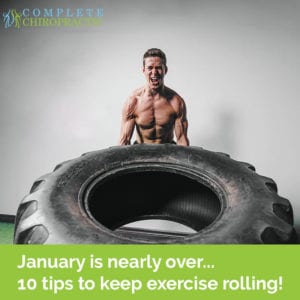January is almost over, and with a bit of luck you’re managing to stick to your health and fitness goals – that being said, it’s normal and expected that after a month of hard work things can start to slip. One approach to this is to get stricter with yourself, and while that can work you might also consider doing something differently, more effectively or just mixing it up a little bit. This week, let’s check out some top exercising tips which may help!

- Know why you’re working out.
Do you still remember why you’re exercise anyway?! Considering the amount of time and effort that’s going to go into your workouts, you need to have a clear goal and purpose in mind before you start. Your goals will also inform the way you train, so take a minute to decide, or reconfirm whether you’re looking to get fitter, lose fat or build muscle. Make your you’re training towards your goal, and switch it up if things don’t feel right! Weight lifting won’t ever make you more flexible!
- The truth about losing weight.
Exercise is only 50% of the equation, perhaps even less when it comes to weight loss. In order to lose weight, you need to plan and stick to a combined plan of diet and exercise, which will leave your body in a manageable calorific deficit. Exercising without a diet, or dieting without exercise are both likely to fail.
- Remember: Energy Breeds energy
Energy breeds energy – so if you’re falling asleep at work all day some exercise may actually be the solution! On days when you’re not really feeling up to the gym too, the best strategy is often to just get going – more often than not you find that you quickly discover the energy to make it through the workout. That being said, do not apply the same logic to pain – pain, even minor pain, is a signal something isn’t right. Change exercise, and get some help if pain persists.
- The relation between stretching and age.
As you age, muscles slowly become less pliable. It’s a good idea to slightly increase the length of stretching as you age. This is especially true of individuals who do not exercise every day. In your 20s and 30s, 30 seconds per stretch is likely to be more than adequate for a general warm-up, whereas in your 40s and 50s the figure should be closer to 60 seconds. Take an extra few sections, and avoid injury!
- Reward yourself after every workout session.
It’s easy to see exercise (and especially weight loss) as all about restrictions, but this isn’t a great mindset for motivation. Instead, a good way to keep your motivation up, and begin to mentally condition yourself to both enjoy and look forward to your workout sessions, is be sure to reward yourself afterwards. Try to avoid food based rewards (or at least plan them into your diet plan) – perhaps use your favourite TV show or hobby instead.
- Build more muscles to lose weight.
Muscles are essentially calorie-burning machines! The more muscle you have, the more calories your body will burn on a daily basis, just as a result of living. Weight training itself also requires the burning of a lot of calories. All good weight loss programs should contain a resistance component, even if it’s just a simple session with resistance bands at home.
- Don’t forget your core!
It is important to build and maintain a strong core in order to perform many other exercises correctly, as well as to protect and strengthen the spine. Most free weight exercises require good core strength, without which you expose yourself to a higher risk of injury. Core strengthening can also make a big difference to your everyday life, and can often go some way to alleviating back pain and postural problems.
- Never exercise without water.
Water is essential for regulating body temperature and electrolyte balance. Drinking water during exercise helps to ‘fuel’ your muscles, and of course – prevent dehydration. It’s easy to forget this, especially when exercising outside in winter, so watch out!
- The best cardio…
When performing cardiovascular exercise for fat loss, consider using high-intensity interval training or a similar high energy approach to burn the most calories possible in the shortest time. HITT is especially easy to do with free bodyweight exercises, as opposed to machines.
- How to determine if you are working out at a ‘moderate’ level of intensity.
Lot’s of diet and exercise guides and even many fitness professionals will often talk about ‘working at a moderate intensity’ but what exactly constitutes moderate? An easy rule of thumb is that If you are still able to talk while you are working out, but it’s a bit difficult to get out a long sentence – then you’re doing it right. During “intense” exercise, you’ll probably struggle to say more than a few words, whereas during “light” exercise, it’s possible to talk almost normally.

